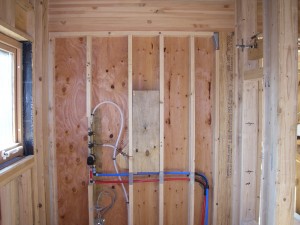 For this sub-section, also required in both the prescriptive and performance pathways, all domestic hot water piping needs to have R-4 insulation. Insulation needs to be properly installed on all piping to elbows to adequately insulate the 90-degree bend. This helps reduce energy use and keep the water temperature as high as possible.
For this sub-section, also required in both the prescriptive and performance pathways, all domestic hot water piping needs to have R-4 insulation. Insulation needs to be properly installed on all piping to elbows to adequately insulate the 90-degree bend. This helps reduce energy use and keep the water temperature as high as possible.
As a background, I think we need to start with the types of pipes that are out there. Copper has been the metal of choice for plumbing fixtures because it is a relatively soft metal, so it can bend easily and requires fewer metal fasteners. It is also resistant to bacteria, contains no lead, and resists corrosion – so it is very durable. Our central manifold uses copper for those reasons. In 2006, though, the price of copper rose dramatically, and though it peaked then, it still is expensive, so many plumbers are switching to plastic pipes. Plastic pipes can be made of PVC, CPVC, or PEX. PVC is polyvinyl chloride — one of the most widely used plastics in the world and one of the most toxic, from cradle to grave. I was clear with our builders I wanted absolutely NOTHING PVC in our house. (There is one air pipe that vents to the outside that simply could not be found in anything other than PVC, so we got 99.9% there. But then, there are toys.) PVC piping is also meant to be used for cold water applications only. For hot water applications, CPVC, or chlorinated polyvinyl chloride is often used. It’s the same thing, to me – no CPVC either.
We ended up using PEX for all of the plumbing beyond the copper central manifold. PEX, which is cross-linked polyethylene, has been used in Europe for decades and in the United States since about 1980, according to the PEXinfo site. Its benefits are that it resists build up of chlorine and scale, will not develop pin holes; since it is flexible it is much easier to install and requires fewer fittings. From what I can tell, PEX does not leach any chemicals into the water, but I’ve seen mixed reviews on the toxicity of PEX. Unlike copper, it cannot be recycled.
Back to the point…our hot water piping needs to have R-4 insulation. This point has caused me some grief in getting the correct information. If you type in “PEX R Value” in Google, you get all sorts of comments that the R Value is better than copper. But what is the R value? Our plumber did not know. I called the technical service department of Uponor, the company that supplies PEX tubing. They emailed me a chart of the R values of the piping, because of course it varies with the size of the pipes. The 1/2″ pipe has an R value of 0.198; the 1″ pipe has an R value of 0.192. Not even close to 4! How would we even get to 4? We would have to wrap all pipes in pretty thick insulation, which would no doubt cost a lot in materials and labor. Would it have been worth the energy savings due to heat loss from the pipes? I really don’t think so. No point here.
Energy & Atmosphere Points so far: 25.5
Cumulative points: 56.5
Additional points needed to get to Gold: 31.5
EA Prescriptive Path points so far: 9
